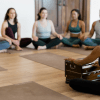
Chaturanga is an integral pose in any yoga sequence – often done several times in a class. It can also be one of the most challenging yoga poses to master. It is important to learn how to properly do this pose because doing this pose incorrectly over and over again can create serious shoulder and wrist issues. Chaturanga is a combination of arm, core, upper back, and wrist strength so building strength in these body parts are key. Building strength in these areas will help to create optimal alignment for the pose.
The best way to practice is by starting off with a modified half Chaturanga on the knees. This pose is done with the exact same alignment principles as Chaturanga – the only difference is that it is done with the knees on the ground. Everything else; the core, shoulders, arms, upper back, and hands should be fully engaged as in the full expression of the pose.
How To Do Chaturanga
1. Start in plank pose with your wrists directly under your shoulders. If this is too much for you, you can come down to the knees and do a modified half Chaturanga.
2. Engage the leg muscles and core muscles.
3. Begin to roll forward slightly on the toes – this will help to bring the arms down to a 90-degree angle.
4. Keep the elbows hugged into the body and ribs. Begin to lower the body down slowly.
5. Keep the upper shoulder and back muscles engaged to keep the chest from collapsing down towards the mat.
6. Bring the arms perpendicular to a 90-degree angle so that the elbows are pointed back towards the feet.
7. Pause and slowly come down to the mat with control.
3 Tips To Mastering Chaturanga
1. Engage The Upper Back Muscles
Chaturanga requires that our upper back muscles are engaged to help support the upper body from collapsing down. To work on strengthening your upper back muscles, you can do push ups or practice Dolphin pose. Dolphin pose helps to target and strengthen muscles in our shoulders and upper back.
2. Squeeze The Elbows In
Squeeze in or hug your elbows into your ribs. This will support your arms and activate different muscles in your arms, for example your triceps and biceps, for more precision and control.
3. Use The Core
Your core will help to support your spine and protect your upper body from collapsing down. Keep the core tight and engaged when doing Chaturanga. To practice strengthening your core muscles, you can hold plank for 30 seconds to a 1 minute or practice Boat pose several times.




